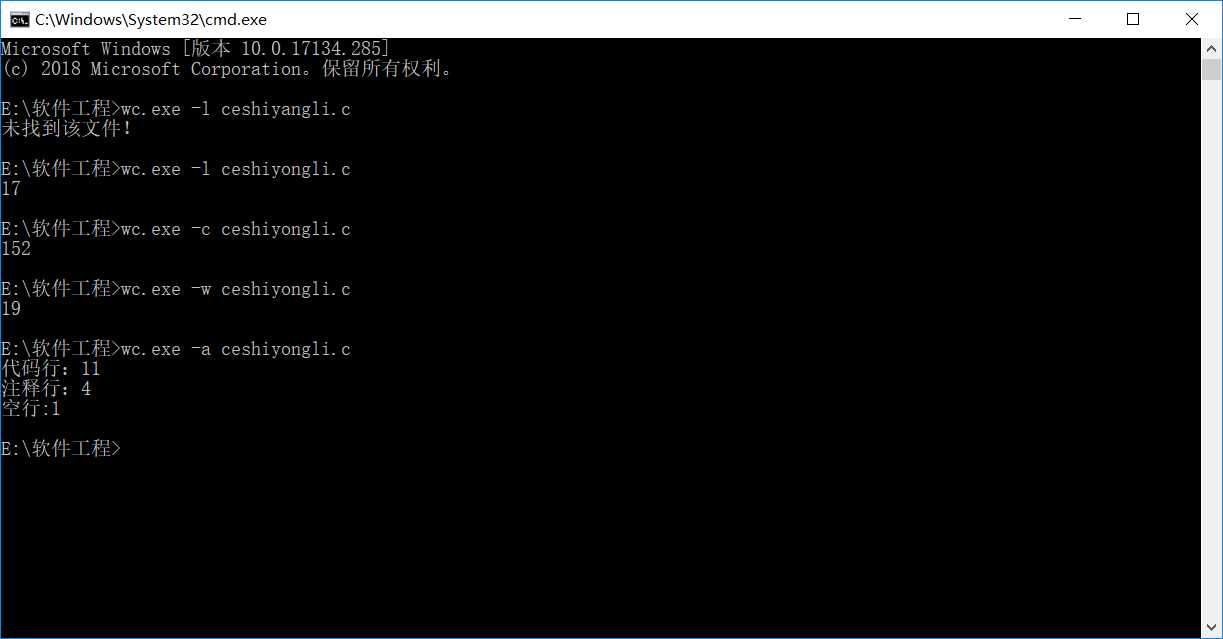python 实现 wc.exe
Posted andyvirginia
tags:
篇首语:本文由小常识网(cha138.com)小编为大家整理,主要介绍了python 实现 wc.exe相关的知识,希望对你有一定的参考价值。
前言:
- Github地址:https://github.com/AndyVirginia/WC
项目简介:
wc.exe 是一个常见的工具,它能统计文本文件的字符数、单词数和行数。这个项目要求写一个命令行程序,模仿已有wc.exe 的功能,并加以扩充,给出某程序设计语言源文件的字符数、单词数和行数。实现一个统计程序,它能正确统计程序文件中的字符数、单词数、行数,以及还具备其他扩展功能,并能够快速地处理多个文件。
- 具体功能要求:
程序处理用户需求的模式为:wc.exe [parameter] [file_name] - 基本功能列表:
wc.exe -c file.c//返回文件 file.c 的字符数(实现)wc.exe -w file.c//返回文件 file.c 的词的数目(实现)wc.exe -l file.c//返回文件 file.c 的行数(实现) -
拓展功能:
- -s 递归处理目录下符合条件的文件。(未实现)
- -a 返回更复杂的数据(代码行 / 空行 / 注释行)。(实现)
- 空行:本行全部是空格或格式控制字符,如果包括代码,则
只有不超过一个可显示的字符,例如“{”。 - 代码行:本行包括多于一个字符的代码。
- 注释行:本行不是代码行,并且本行包括注释。一个有趣的例子是有些程序员会在单字符后面加注释:
} //注释
在这种情况下,这一行属于注释行。 - [file_name]: 文件或目录名,可以处理一般通配符。(未实现)
- -s 递归处理目录下符合条件的文件。(未实现)
- 高级功能:
- -x 参数。这个参数单独使用。如果命令行有这个参数,则程序会显示图形界面,用户可以通过界面选取单个文件,程序就会显示文件的字符数、行数等全部统计信息。(未实现)
需求举例:wc.exe -s -a *.c
返回当前目录及子目录中所有*.c 文件的代码行数、空行数、注释行数。
PSP:
|
Personal Software Process Stages |
预估耗时(分钟) |
实际耗时(分钟) |
|
计划 |
||
|
-估计这个任务需要多少时间 |
60 | 70 |
|
开发 |
||
|
·-需求分析 (包括学习新技术) |
180 | 150 |
|
-生成设计文档 |
60 | 60 |
| -代码规范 (为目前的开发制定合适的规范) | 30 | 30 |
| -具体设计 | 120 | 120 |
|
-具体编码 |
240 | 300 |
| -代码复审 | 60 | 80 |
| -测试(自我测试,修改代码,提交修改) | 60 | 60 |
|
报告 |
||
|
-测试报告 |
60 | 60 |
| -计算工作量 | 30 | 30 |
|
-事后总结, 并提出过程改进计划 |
60 | 60 |
| 总计 |
解题思路:
- 行数统计:最初有两个方案,
- 使用readlines函数,readlines()会一次性读取文件并将每一行作为一个元素存放到一个列表中,可以通过len()获取列表长度从而知晓文件的行数;
- 使用read()函数读取整个函数,通过count()函数获取文件中换行符的个数,换行符个数加一即可得到文件的行数;
- 词数统计:我认为文件中的单词应以字母开头,设置一个标记,逐个字符遍历文件,遇到非字母时置标记为真,遇到字母时通过检查标记来确定是不是一个单词;
- 字符数统计:逐个遍历确认是否是字母,或者使用spilt()筛除字符串中的非字符部分。
- 命令行参数部分:使用python自带的Optparse函数实现。
- 注释行、空行,代码行计数:逐个字符遍历,通过三个状态变量确认代码文件当前字符是否处于块注释、行注释或字符串中,并设置一个计数器通过状态标记计算当前行的代码字符个数以确定当前行的种类。
- 使用pyinstaller将代码打包成exe文件
关键代码:
主函数:
使用if-elif-else结构读取命令行,并跳转到指定的函数,输出结果。
def main():
# 主程序
parser = OptionParser()
parser.add_option(‘-c‘,‘--char‘, dest = ‘char‘, action = ‘store‘,
default = False, help = ‘only user to count chars‘)
parser.add_option(‘-l‘, ‘--line‘, dest = ‘line‘, action = ‘store‘,
default = False, help = ‘only user to count lines‘)
parser.add_option(‘-w‘, ‘--word‘, dest = ‘word‘, action = ‘store‘,
default = False, help = ‘only user to count words‘)
parser.add_option(‘-a‘, dest = ‘type‘, action = ‘store‘,
default = False, help = ‘only user to count type of line‘)
option, args = parser.parse_args()
if option.char:
print(chars(option.char))
elif option.line:
print(lines(option.line))
elif option.word:
print(words(option.word))
elif option.type:
print(type(option.type))
else:
print(‘无效的命令行参数!‘)
行数统计:
计算文件中的换行符个数
def lines(args):
‘‘‘ 返回文件 file.c 的行数‘‘‘
try:
with open(args,‘r‘,encoding=‘UTF-8‘) as file:# 指定读取的编码方式为UTF-8
i = file.read().count(‘
‘)
return i+1
except FileNotFoundError:
return ‘未找到该文件!‘
词数统计:
通过判断字母前是否有非字母字符存在来确定一个单词的开始,并使计数器+1
def words(args):
# 返回文件单词数
try:
with open(args,‘r‘,encoding=‘UTF-8‘) as f:
file = f.readlines()
space_flag = False # 标记上一个字符是否为空格
words_num = 0
for x in file:
for y in x:
if (y < ‘A‘ or y >‘Z‘) and (y < ‘a‘ or y > ‘z‘):
space_flag = True
else:
if space_flag == True:
words_num += 1
space_flag = False
return words_num
except FileNotFoundError:
return ‘未找到该文件!‘
字符数统计:
def chars(args):
# 返回文件字符个数
try:
with open(args,‘r‘,encoding=‘UTF-8‘) as f:
file = f.readlines()
num = 0
for x in file:
for y in x:
if (y >= ‘A‘ and y <= ‘Z‘) or (y >= ‘a‘ and y <=‘z‘):
num += 1
return num
except FileNotFoundError:
return ‘未找到该文件!‘
拓展功能:支持 -a 参数:
对正则表达式的使用还不是很熟练,所以使用了类似c的实现
总共设置了5个标记:mark_flag(当前是否处于字符串中)、block_comment_flag(当前是否处于一个块注释中)、line_comment_flag(当前字符是否在一个行注释中)、slash(前一个字符是否是一个斜杠)和
asterisk(前一个字符是否是一个*)。并设置了一个计数器计算当前行的代码字符数。
def type(args):
space_line = 0
comment_line = 0
code_line = 0
try:
with open(args,‘r‘,encoding=‘UTF-8‘) as file:
mark_flag = False # 双引号标记
block_comment_flag = False # 块注释标记
for line in file.readlines():
line_comment_flag = False # 行注释标记
code_num = 0 # 行代码字符数
slash = False
asterisk = False
for char in line:
if char != ‘ ‘:
if block_comment_flag == False and line_comment_flag == False:
# 不处于注释中时记录代码字符个数
code_num += 1
if char == ‘"‘ and not block_comment_flag:
# 当当前的字符不处于一条注释中时,对字符串进行判定
if mark_flag:
# 如果字符串已开始,结束字符串
mark_flag = False
else:
# 否则开始一个字符串,置标记为真
mark_flag = True
elif char == ‘/‘ and not mark_flag and not block_comment_flag:
# 当当前不处于字符串和块注释中,对注释进行判定
if not slash:
slash = True
else:
# 当前一个字符为一个斜杠,说明此时开始了一个行注释
line_comment_flag = True
# 前面计数器将两个斜杠记为代码字符,应减去避免统计错误
code_num -= 2
elif slash and char == ‘*‘ and not mark_flag:
# 当当前不处于字符串时,判断一个块注释
block_comment_flag = True
code_num -= 2
elif block_comment_flag and char == ‘*‘:
# 判断在块注释中是否出现一个星号
asterisk = True
elif asterisk:
if char == ‘/‘:
# 结束一个块注释,并将其最后一行作为行注释处理
block_comment_flag = False
line_comment_flag = True
if code_num > 1:
# 若当前行代码字符超过1视为代码行
code_line += 1
else:
if block_comment_flag or line_comment_flag:
comment_line += 1
else:
space_line += 1
return ‘代码行:‘+str(code_line)+‘
注释行:‘+str(comment_line)+‘
空行:‘+str(space_line)
except FileNotFoundError:
return ‘找不到该文件‘
测试:
测试样例:
#include <stdio.h>
#include <stdlib.h>
int main()
{
/*
wozhishiyonglaiceshi
*/
printf("Hello,world");
printf("/*
kankanxingbuxing
*/");
system("pause");//zhexiezhushiqishishimeiyouyongde
//nikeyibukan
return 0;
}

项目小结:
- 对python的学习还不够深入,在实现某些功能时,由于缺乏理解不能使用比较好的实现方法,还需要继续学习;
- 对程序逻辑还不够清楚,实现的时候没有办法很好的理清思路,空耗了较长的时间,这一点需要通过多敲代码来提升水平。